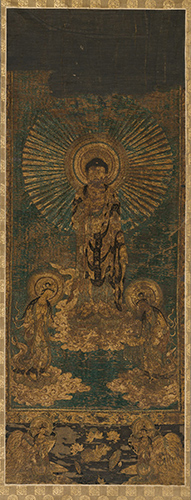Until recently, it was believed that an eight-by-four-foot hanging textile, decorated with crosses and floral motifs and made in the resist-dyed technique, originated from medieval Egypt and was dated as late as the 13th century. Its large size, good condition, and somewhat unusual design (a purely ornamental/floral pattern) contributed to that opinion. However, radiocarbon analysis has revealed that the textile was actually created sometime between the 5th and 7th centuries CE, squarely within the Byzantine period. Polarized light analysis uncovered another interesting fact: the object was made of cotton, an atypical material for textiles from this place and time.
“Most Byzantine textiles in museum collections are tapestry woven in wool and linen; resist-dyed fabrics are much rarer, and only a few cotton examples exist in a Byzantine context,” said Katie Taronas, a Ph.D. student in Harvard’s History of Art and Architecture program who spent the 2016 spring semester as an intern in the Harvard Art Museums’ Division of Asian and Mediterranean Art. Her first project as part of her internship was determining where the cotton in the textile originated, an assignment that led her to study the practice of weaving and the use of different materials, as well as to examine many more examples of Byzantine works. “It was a great way to expand my knowledge,” said Taronas, whose academic focus is Byzantine art.
Ultimately, her research suggested that the cotton was imported from India (making it important physical evidence of Late Antique trade across the Red Sea), but that the textile was likely dyed with Christian motifs after it reached Egypt. The object now hangs in the museums’ Egyptian gallery. “It’s such a visually impressive piece, and probably my favorite of all the textiles I’ve studied,” Taronas said.
Taronas, as well as other curatorial staff and conservators, have had the chance to get to know the museums’ textiles much better in recent years, as many of the objects have been newly conserved and analyzed in the Straus Center for Conservation and Technical Studies. A notable impetus for this initiative has been the support of the Hagop Kevorkian Fund, which helped the museums conserve selected textiles from early Byzantine Egypt. Some of the textiles were also gifts of the Hagop Kevorkian Foundation, including the cotton textile mentioned above.
As textiles have undergone conservation and analysis, curators have included them in a series of installations. “It’s been great to learn more about these pieces and to be able to showcase them in our galleries on a regular basis,” said Amy Brauer, the Diane Heath Beever Curator of the Collection in the Division of Asian and Mediterranean Art.
Conservators’ Contributions
While textiles of all types are studied and analyzed in the Straus Center on an as-needed basis, approximately two dozen early Byzantine textiles are the latest that have been conserved. Without an in-house textiles conservator, Anne Driesse, senior conservator of works of art on paper, has overseen management of outside conservation work (carried out by textile specialists Kathleen MacKay of Westborough, Massachusetts, and Deirdre Windsor of Dover, Massachusetts). In-house analysis, as well as mounting and re-housing of textiles, has been managed by Driesse, alongside Georgina Rayner, the Andrew W. Mellon Postdoctoral Fellow in Conservation Science; and conservation technicians Charlotte Karney and Polixeni Theodorou.
Rayner has closely studied the colors and fibers in each piece. She extracts small samples from each object, and, partnering with the Museum of Fine Arts, Boston, in the use of its laboratory, she analyzes and identifies the dyes present through liquid chromatography (which separates the chemical components that provide color). In addition, she analyzes the fiber in the samples with polarized light, to determine the textiles’ composition—providing firm identification of whether a work was made with cotton, linen, wool, or other materials. “We’re really just trying to understand what these textiles are made of, so we can add to the information that’s already been written up,” Rayner said.
Conservation work has focused mainly on stabilizing each textile to allow for scholarly research and to develop a storage and display system to eliminate unnecessary handling and framing. Current treatments seek to restore works as closely as possible to their original appearances, without making any unnecessary additions or subtractions. Much of the work has to do with consolidation: catching loose threads before textiles unravel.





